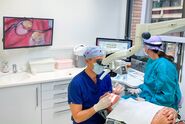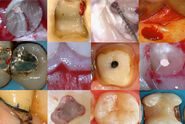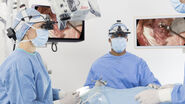Optical quality
A dental microscope is at its core an optical instrument, which allows the dentist to see enhanced detail in order to work as precisely as possible. Therefore, there should be no compromise concerning the optical components. Only superior optical quality with excellent clarity offers high resolution, large depth of field, and maximum light transmission.
This is indispensable for a successful root canal treatment as the root canals are in most cases not rectilinear and have cavities and tiny ramifications, which are difficult to detect without high magnification and depth of field. Accurate color representation is also required for easy differentiation of anatomical details. Optics with apochromatic correction, as integrated in the Leica M320 dental microscope, provide images without any color distortion.
Illumination
In combination with optical quality, illumination plays a key role in the brightness and color of the image that the dentist sees through the eyepiece. For natural color representation, light with daylight temperature of between 5,000 and 6,000 kelvin is optimal.
Another factor to consider is the life-span of the light source as this impacts on cost of ownership, potential downtime, and the environment. Compared to Xenon or Halogen, LED illumination usually lasts much longer. The LED bulbs in the M320 have a temperature of 5,500 kelvins for true-to-life color and offer approx. 60,000 hours of light. A longer lifetime reduces the frequency of bulb exchange and therefore potential microscope downtime.
The location of the light source may also influence its life span. When the light source is located in the microscope stand, the light needs to be transmitted with fiber optic cable through the arm to the optics carrier.
The fiber optics can be subjected to wear and tear through everyday microscope adjustment, which over time could impact on the light reaching the treatment site. The M320 is designed with the LED bulbs directly in the optics carrier to avoid this potential cause of brightness degradation.
Documentation
Today, video and images plays an ever increasing role within the dental practice for a number of reasons. Firstly during a procedure, live on-screen video can help the assistant to support the dental surgeon. Video is also a useful training tool either during or post treatment and can additionally be shared with the wider dental community online or at seminars.
Additionally video can support patient relationships and trust as the dentist can show the patient what he sees, take them through the steps of a procedure and thus include them in consultation and treatment.
Finally video and images can be included in a patient’s file for more thorough documentation and to facilitate easy review. Ease of transfer to a practice documentation system and the ability to save different file formats are therefore further key considerations.
The M320 dental microscope has an optional integrated full HD 1080p camera and only requires a push of a button for still or video capture, with no interruption of the workflow. Data can be saved to SD memory card or transferred directly to the patient file via USB.
Ergonomic design
Musculoskeletal pain caused by a hunched working position and harsh, repetitive movements, can have a serious impact on the dentist’s professional and personal life. Using a microscope during dental procedures helps the dentist to maintain a neutral, upright working position. Modern microscopes should also offer a variety of ergonomic accessories to adapt the microscope to the user’s individual body frame and working preference.
The M320 dental microscope features two binocular tubes with a 45˚ angle for simple procedures and another with 180˚ movement for increased positioning flexibility. The ErgoWedge accessory supports positioning ease and the ErgonOptic Dent accessory further extends the reach of the microscope and provides a greater range of movement by allowing the optics carrier to swivel to the angle needed while maintaining an ergonomic posture.
Workflow integration
A microscope’s design does not only have the aesthetics in mind, but also the functionality. A carefully considered design should make it easy to integrate the microscope into the practice environment and even improve the workflow. The M320 was designed with the individual needs of the dentists in mind: Its streamlined design with various mounting options, including the possibility to integrate with several treatment units, allows it to be tailored to the individual demands of each practice.
Quick, lightweight, and accurate positioning combined with fast stabilization supports a smooth workflow. The optional MultiFoc Objective with a variable working distance from 200 mm to 300 mm allows the dentist to refocus quickly and easily as necessary. Being able to change between different focus levels during examination and treatment without having to reposition minimizes workflow interruptions which can help the dentist to maintain efficiency and concentration.
Hygiene
In a dental practice a high standard of cleanliness is a prerequisite and each piece of equipment should make it as easy as possible to maintain this high standard. A streamlined design with cables routed internally from the optics carrier to the stand, makes a microscope easier to clean and also avoids accidental cable damage. Additional features such as the antimicrobial coating on the M320 can further support hygiene by minimizing pathogens on the microscope as well as their possible transmission to team members or patient.









